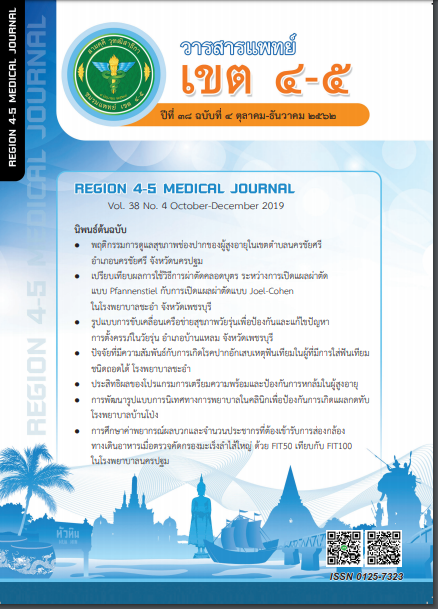The Positive Predictive Value and Number Needed to Colonoscope of Fecal Immuno-Chemical Test 50 versus 100 for Colorectal Screening in Nakhonpathom Hospital
Keywords:
cut-off fecal immunochemistry test, colorectal cancer screening, positive predictive value, number needed to colonoscopyAbstract
Objective : Comparing positive predictive value and number needed to colonoscope between FIT 50 and FIT 100 for colorectal screening in Nakhonpathom Hospital.
Methods : In this retrospective study , asymptomatic participants , 50-70 years old with average risk for colorectal cancer, attended screening programs in Nakhon Pathom Province with FIT 50 in 2016 and FIT 100 in 2017. Positive predictive value, number needed to colonoscope, positive rate, dropout rate were collected and compared by using chi-square test
Results : All participants in colorectal screening program with FIT 50 were 4,100 and FIT 100 were 6,896. Comparing between FIT 50 with FIT 100 , we found that FIT positive rates were 12.7% and 3.6% (p<.001) respectively. Dropout rates were 28.9% and 14.9% (p<.001) respectively. Incidence rates of colorectal polyp were 3.0% and 1.1% (p<.001) and incidence rates of colorectal cancer were 0.37% and 0.17% (p=.049) in general population respectively. PPV for polyp were 34.3% and 30.8% (p=.356), PPV for cancer were 4.3% and 5.7% (p=.283), and PPV for both polyp and cancer were 38.6% and 36.5% (p=.659). Numbers needed to colonoscope of FIT 50 and 100 for polyp were 3 and 4 respectively. Numbers needed to colonoscope for cancer were 24 and 18 and numbers needed to colonoscope for both polyp and cancer were equally (3).
Conclusion : FIT 100 ng/ml is an appropriate tool for colorectal screening in a country which is limited to personal and colonoscopy resources due to equal PPV and lowering number needed to colonoscope when compares with FIT 50 ng/ml.
References
2. Khuhaprema T, Attasara P, Sriplung H, et al. Cancer in Thailand Volume VI, 2004–2006 . Bangkok: National cancer Institute of Thailand, Ministry of public health; 2012.
3. Khuhaprema T, Srivatanakul P, Attasara P, et al. Cancer in Thailand Volume V, 2001–2003. Bangkok:National cancer Institute of Thailand, Ministry of public health; 2010.
4. Imsamran W, Chaiwerawattana A, Wiangnon S, et al. Cancer in Thailand Vol.III, 2010-2012. Bangkok: New Thammada Press; 2015:31.
5. Imsamran W, Pattatang A, Supaatagorn P, et al. Cancer in Thailand Vol.IX, 2013-2015. Bangkok: New Thammada Press; 2018:28.
6. World Health Organization. Cancer control: knowledge into action: WHO guide for effective programmes. Geneva: WHO; 2006-2008.
7. Hewitson P, Glasziou P, Watson E, et al. Cochrane systematic review of colorectal cancer screening using the fecal occult blood test (hemoccult): an update. Am J Gastroenterol 2008;103(6):1541-9. doi: 10.1111/j.1572-0241.2008.01875.x.
8. Van Hees F, Zauber AG, van Veldhuizen H, et al. The value of models in informing
resource allocation in colorectal cancer screening: the case of the Netherlands. Gut. 2015; 64(12): 1985–97. doi: 10.1136/gutjnl-2015-309316.
9. กันต์กมล กิจตรงศิริ, นัยนา ประดิษฐ์สิทธิกร, อุษา ฉายเกล็ดแก้ว, และคณะ. การศึกษาความคุ้มค่าของการตรวจคัดกรองมะเร็งลำไส้ใหญ่และไส้ตรงในประชากรไทย Economic evaluation of colorectal cancer screening among Thai population ภายใต้โครงการศึกษาเพื่อพัฒนาชุดสิทธิประโยชน์ภายใต้ระบบหลักประกันสุขภาพถ้วนหน้า. กรุงเทพฯ: สำนักงานหลักประกันสุขภาพแห่งชาติ; 2557.
10. Halloran SP, Launoy G, Zappa M, et al. European guidelines for quality assurance in colo-rectal cancer screening and diagnosis. First Edition-Faecal occult blood testing. Endoscopy 2012; 44:65-87.
11. Aniwan S, Ratanachu Ek T, Pongprasobchai S, et al. The Optimal Cut-Off Level of The Fecal Immunochemical Test For Colorectal Cancer Screening in a Country with Limited Co-lonoscopy Resources: A Multi-Center Study from Thailand. Asian Pac J Cancer Prev. 2017;18(2):405-12.
12. Hermann B, Simone W. Selecting a Cut-off for Colorectal Cancer Screening With a Fecal Immunochemical Test. Clin Transl Gastroenterol. 2017;8(8) e111.
13. Nielson CM, Petrik AF, Jacob L, et al. Positive predictive values of fecal immunochemical tests used in the STOP CRC pragmatic trial. Cancer Med. 2018;7:4781–90.
14. Shahidi N, Gentile L, Gondara L, et al. Correlating Quantitative Fecal Immunochemical Test Results with Neoplastic Findings on Colonoscopy in a Population-Based Colorectal Cancer Screening Program: A Prospective Study. Can J Gastroenterol Hepatol. 2016;2016:4650471. doi: 10.1155/2016/4650471.

Downloads
Published
How to Cite
Issue
Section
License
ลิขสิทธิ์บทความเป็นของผู้เขียนบทความ แต่หากผลงานของท่านได้รับการพิจารณาตีพิมพ์ลงวารสารแพทย์เขต 4-5 จะคงไว้ซึ่งสิทธิ์ในการตีพิมพ์ครั้งแรกด้วยเหตุที่บทความจะปรากฎในวารสารที่เข้าถึงได้ จึงอนุญาตให้นำบทความในวารสารไปใช้ประโยชน์ได้ในเชิงวิชาการโดยจำเป็นต้องมีการอ้างอิงถึงชื่อวารสารอย่างถูกต้อง แต่ไม่อนุญาตให้นำไปใช้ในเชิงพาณิชย์


